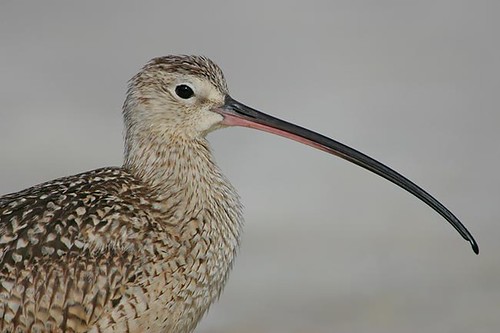
Long-billed Curlew, Numenius americanus.
Image appears here with the kind permission of the photographer, Arthur Morris, Birds as Art.
Click image for larger view in its own window.
Birds and Science
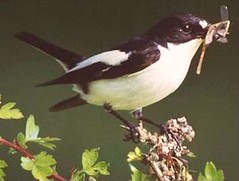 Some pied flycatchers, Ficedula hypoleuca (pictured), a common migratory bird slightly smaller than a sparrow, are missing their spring meals and dying as a result of climate change, a team of scientists reported this week. The discovery is one of the most sophisticated showing the domino effect of shifting seasons and their impact on predators and prey. The migratory birds fly thousands of kilometers each spring from wintering grounds in Africa to Europe, where they breed. "It's impossible for them to predict when the spring starts in Europe," says University of Groningen evolutionary ecologist Christiaan Both. That has had a profound impact, the team reported in the 4 May issue of the top-tier journal, Nature. Among nine flycatcher populations they studied over 2 decades, the researchers found that those that mistimed their arrival declined in number by a stunning 90%, compared to better-synchronized groups that suffered only a 10% drop.
Some pied flycatchers, Ficedula hypoleuca (pictured), a common migratory bird slightly smaller than a sparrow, are missing their spring meals and dying as a result of climate change, a team of scientists reported this week. The discovery is one of the most sophisticated showing the domino effect of shifting seasons and their impact on predators and prey. The migratory birds fly thousands of kilometers each spring from wintering grounds in Africa to Europe, where they breed. "It's impossible for them to predict when the spring starts in Europe," says University of Groningen evolutionary ecologist Christiaan Both. That has had a profound impact, the team reported in the 4 May issue of the top-tier journal, Nature. Among nine flycatcher populations they studied over 2 decades, the researchers found that those that mistimed their arrival declined in number by a stunning 90%, compared to better-synchronized groups that suffered only a 10% drop.
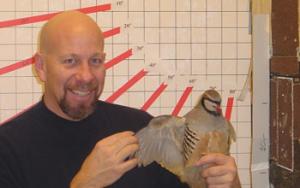 Biologists have long argued about how birds evolved flight, because it is not immediately evident what improvement in fitness would result from ancestral, partly evolved wings. In fact, St. George Jackson Mivart first framed the debate in 1871 by asking: "What use is half a wing?" Recently, two hypotheses have dominated the debate: one postulates that flight evolved in tree-dwelling ancestors that used their forelimbs to help them glide, while the other considers ancestral birds to be terrestrial dinosaurs that developed powered flight from the ground up. An article by Kenneth Dial and two co-authors in the May 2006 issue of BioScience summarizes experimental evidence indicating that ancestral protobirds that were incapable of flight could have used their protowings to improve hindlimb traction and thus better navigate steep slopes and obstructions. By using their protowings in this way, they presumably had an advantage when pursuing prey and escaping from predators. Dial and colleagues have named this form of locomotion "wing-assisted incline running" (WAIR).
Biologists have long argued about how birds evolved flight, because it is not immediately evident what improvement in fitness would result from ancestral, partly evolved wings. In fact, St. George Jackson Mivart first framed the debate in 1871 by asking: "What use is half a wing?" Recently, two hypotheses have dominated the debate: one postulates that flight evolved in tree-dwelling ancestors that used their forelimbs to help them glide, while the other considers ancestral birds to be terrestrial dinosaurs that developed powered flight from the ground up. An article by Kenneth Dial and two co-authors in the May 2006 issue of BioScience summarizes experimental evidence indicating that ancestral protobirds that were incapable of flight could have used their protowings to improve hindlimb traction and thus better navigate steep slopes and obstructions. By using their protowings in this way, they presumably had an advantage when pursuing prey and escaping from predators. Dial and colleagues have named this form of locomotion "wing-assisted incline running" (WAIR).
The Erebus Scarecrow - designed by USF computer science students to protect both the investment of aqua-farmers and the lives of birds that may prey upon their fish - does not, unlike the scarecrow of Oz fame, have a "head all full of stuffing." Erebus has a head all full of sophisticated but relatively low cost sensors, cameras and other hi-tech computer components that will keep predator birds away from fish farm ponds without harming the birds. "Aquaculture, also known as fish farming, is a vital part of the world's fish production and a $40 million business in Florida," said Christensen. "The outdoor farms are susceptible to predator birds. The students' intelligent scarecrow is designed to benefit farmers while protecting predator birds - many of which are protected species - from harm." GrrlScientist comment: I am pleased to see that there are a few people in the world who are intelligent enough to deal with birds without killing them, as so many people are so eager to do.
People Helping Birds
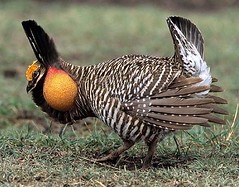 The lights of a city 15 miles away are still glowing on the horizon when rustling is heard in the prairie grass. Soon darkness will give way to a spectacular show. It's the annual mating ritual of the greater prairie-chickens, Tympanuchus cupido (pictured), who gather on this man-made breeding stage east of Fargo, North Dakota every spring. The area is known as a booming ground, named for the bassoon-like sounds made by the male birds. This particular booming ground, known as Bluestem Prairie, covers about 2,900 acres in far western Minnesota. It used to be a gravel pit, to accommodate construction in the area until the Nature Conservancy restoring it into a booming ground in 1990, after clearing rocks and planting native prairie grass. "We get a lot of value out of the prairie chickens," said Brian Winter, the regional program director for the Nature Conservancy. "They're comical, they put on a good show. It can be cold and windy and rainy and they're going to be out there each morning in April and May doing their thing."
The lights of a city 15 miles away are still glowing on the horizon when rustling is heard in the prairie grass. Soon darkness will give way to a spectacular show. It's the annual mating ritual of the greater prairie-chickens, Tympanuchus cupido (pictured), who gather on this man-made breeding stage east of Fargo, North Dakota every spring. The area is known as a booming ground, named for the bassoon-like sounds made by the male birds. This particular booming ground, known as Bluestem Prairie, covers about 2,900 acres in far western Minnesota. It used to be a gravel pit, to accommodate construction in the area until the Nature Conservancy restoring it into a booming ground in 1990, after clearing rocks and planting native prairie grass. "We get a lot of value out of the prairie chickens," said Brian Winter, the regional program director for the Nature Conservancy. "They're comical, they put on a good show. It can be cold and windy and rainy and they're going to be out there each morning in April and May doing their thing."
Would you like to pick up a few pointers for how you can attract birds to your yard? There are a variety of things that you can do. For example, "urban people can do container gardening. They can plant (dwarf) trees, small-scaled shrubs and plants. Hummingbird plants attract birds. Even ships at sea sometimes attract birds during migration because they have a few (potted) trees around," said Steve Kress, vice president for Bird Conservation with the National Audubon Society and author of the newly released "Audubon Society Guide to Attracting Birds: Creating Natural Habitats for Yards Large and Small." More examples listed in the article.
NASA is trying to rid the Kennedy Space Center of vultures after the shuttle struck one of the large carrion-eating birds during lift-off last year on the first flight after the Columbia disaster. The space center has set up what it calls a "road kill posse" to quickly clear as many carcasses as possible from the 6,000-acre site, in hopes of encouraging the vulture population to relocate by cutting off its food supply. About 500 pounds of animal carcasses have been removed since the program began two weeks ago, the center said.
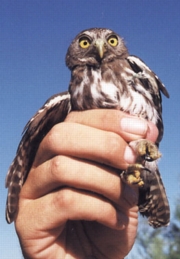 The cactus ferruginous pygmy-owl, Glaucidium brasilianum cactorum (pictured), is on the verge of losing its status as an endangered species. The removal from the endangered species list is scheduled to take place May 15, unless the U.S. Fish and Wildlife Service decision is overruled in court. Fewer than 20 of the tiny owls are known to live in Arizona, most of them in an area northwest of Tucson. The delisting decision followed a lawsuit by the home-building industry that wants to develop the area. This link includes an interview with Jamie Rappaport Clark, a vice president with the environmental group Defenders of Wildlife who visited Arizona last week. [Photographer: Michael Terrio]
The cactus ferruginous pygmy-owl, Glaucidium brasilianum cactorum (pictured), is on the verge of losing its status as an endangered species. The removal from the endangered species list is scheduled to take place May 15, unless the U.S. Fish and Wildlife Service decision is overruled in court. Fewer than 20 of the tiny owls are known to live in Arizona, most of them in an area northwest of Tucson. The delisting decision followed a lawsuit by the home-building industry that wants to develop the area. This link includes an interview with Jamie Rappaport Clark, a vice president with the environmental group Defenders of Wildlife who visited Arizona last week. [Photographer: Michael Terrio]
Some of you might remember that I recently reviewed Jonathan Trouern-Trend's book, Birding Babylon, recently. This interview with the author reveals how birds changed and enhanced his time in Iraq. One of the good things to come of this is the author set up the IraqiFauna Wiki to help protect and restore the biological diversity of Iraq. For those of you who think that one person cannot make a difference, I dare you to read this interview and keep that opinion intact.
Migratory Bird Festivals
North Dakota's state bird and the state's many waterfowl will be celebrated May 13 when Audubon National Wildlife Refuge again marks International Migratory Bird Day. "There are a lot of folks in the area who enjoy bird-watching and feeding birds," said Jackie Jacobson, outdoor recreation planner at Audubon. "(The classes) are another way to appreciated them and learn more about the species. We always focus on species that are relatively common in North Dakota that people can relate to without being an expert birder."
People Hurting Birds
The newest family to move into Sabal Pines, in south Florida, is terrorizing its empty-nester neighbors with territorial attacks, aggressive stances and hawk-eyed stares. And the residents of this 55-and-over community can do nothing but cower from the hawks nesting in a tree overlooking the community clubhouse, where people congregate around the pool. Already the birds have attacked seven people, bloodying one man's head and knocking a woman to her knees. The hawks are protected, but that isn't stopping residents from planning to seek help from wildlife officials. With any luck, they'll end up appealing to the same morons who recently killed the nesting red-shouldered hawks in central Florida. GrrlScientist says: Gee, I have a novel idea, how about using their inherent primate imagination and creativity to deal with the situation (have they ever heard of umbrellas, or hard hats to protect themselves? Or perhaps -- GASP! -- leaving the birds alone while the chick fledges?) Yes, indeed, folks, get ready for more of the finest wildlife management that money can buy!
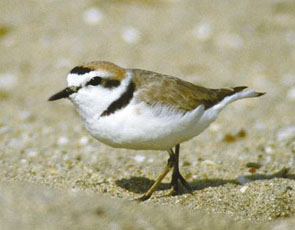 Federal wildlife officials have rejected two petitions to remove the Western snowy plover, Charadrius alexandrinus (pictured), from Endangered Species Act protections, but they proposed easing penalties for harming the tiny shorebirds in areas where the population seems to be recovering. The birds live on Pacific coast beaches, laying their eggs in depressions in open sand where they are vulnerable to predators and people. That has led since 1999 to the closure of the dry sand portions of many miles of beaches during the March-through-September nesting season, just when humans like to go to the beach. The Surf Ocean Beach Commission of Lompoc and the city of Morro Bay had filed to remove the species from federal protection in California, Oregon and Washington, arguing that the snowy plover actually isn't in danger of extinction and isn't genetically distinct from inland populations.
Federal wildlife officials have rejected two petitions to remove the Western snowy plover, Charadrius alexandrinus (pictured), from Endangered Species Act protections, but they proposed easing penalties for harming the tiny shorebirds in areas where the population seems to be recovering. The birds live on Pacific coast beaches, laying their eggs in depressions in open sand where they are vulnerable to predators and people. That has led since 1999 to the closure of the dry sand portions of many miles of beaches during the March-through-September nesting season, just when humans like to go to the beach. The Surf Ocean Beach Commission of Lompoc and the city of Morro Bay had filed to remove the species from federal protection in California, Oregon and Washington, arguing that the snowy plover actually isn't in danger of extinction and isn't genetically distinct from inland populations.
More bird species than ever before are headed towards extinction, according to BirdLife International's annual evaluation of how the world's bird species are faring. Their report shows that the total number considered threatened with extinction is now 1,210. When combined with the number of Near Threatened species this gives a record total of 2,005 species in trouble - more than a fifth of the planet's 9,799 total species. Some species have become extinct before taxonomic studies were completed. "We face a huge challenge in improving the status of the 1,210 threatened and 795 Near Threatened species. But the success stories show that concerted conservation action can save these birds from extinction: we just need the political will and resources," observed Stuart Butchart, BirdLife's Global Species Program Coordinator.
 The British Columbia, Canada, government will implement a multi-million dollar, five year plan to recover the province's critically endangered northern spotted owl, Strix occidentalis caurina (pictured), Agriculture and Lands Minister Pat Bell announced Friday. Environmental groups, whose warnings about spotted owl extinction have fallen on deaf government ears for years, say the plan is just window dressing to make B.C. look good for the 2010 Winter Olympic Games. Under the plan, the government says it will engage in captive breeding and release of spotted owls, moving owls to new locations, increasing food sources for owls, and managing competing species such as barred owls, Strix varia. But logging in the old growth forests that provide spotted owl habitat will not stop. The B.C. government, through its Timber Sales Program, will continue as the largest logger of owl habitat, the conservation groups point out. [Orphan photograph]
The British Columbia, Canada, government will implement a multi-million dollar, five year plan to recover the province's critically endangered northern spotted owl, Strix occidentalis caurina (pictured), Agriculture and Lands Minister Pat Bell announced Friday. Environmental groups, whose warnings about spotted owl extinction have fallen on deaf government ears for years, say the plan is just window dressing to make B.C. look good for the 2010 Winter Olympic Games. Under the plan, the government says it will engage in captive breeding and release of spotted owls, moving owls to new locations, increasing food sources for owls, and managing competing species such as barred owls, Strix varia. But logging in the old growth forests that provide spotted owl habitat will not stop. The B.C. government, through its Timber Sales Program, will continue as the largest logger of owl habitat, the conservation groups point out. [Orphan photograph]
Ivory-billed Woodpecker News
This story about the Ivory-billed Woodpecker, Campephilus principalis, is part history and part opinion. But if the IBWO intrigues you, this story will be of interest. This story also includes an streaming interview with Joel Cracraft, Curator of Birds at the American Museum of Natural History, about the IBWO. This video is viewable after you watch an annoying (but short) ad. [5:04]
Avian Influenza News
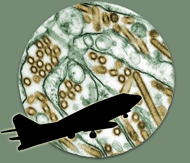 You might think that shutting down air travel from cities affected by a dangerous new influenza strain would put a brake on the subsequent global march of that virus--but you'd be wrong. A new study has found that limiting air travel would have little effect on an influenza pandemic. Now, a paper published in the June issue of the online journal PLoS Medicineexamines travel bans and takes a global perspective. Modeler Ben Cooper and his colleagues at the Health Protection Agency in London used data from the International Air Transport Association about air travel between 105 major cities around the world to model a hypothetical influenza pandemic that started on 1 June of a given year, in Hong Kong. They found that banning travel from flu-affected cities -- which they assumed would be implemented after a city has 100 symptomatic cases -- had little effect on the overall spread of the pandemic; the virus just reached cities elsewhere on the planet a couple of days later than it did without grounding planes. [print PDF].
You might think that shutting down air travel from cities affected by a dangerous new influenza strain would put a brake on the subsequent global march of that virus--but you'd be wrong. A new study has found that limiting air travel would have little effect on an influenza pandemic. Now, a paper published in the June issue of the online journal PLoS Medicineexamines travel bans and takes a global perspective. Modeler Ben Cooper and his colleagues at the Health Protection Agency in London used data from the International Air Transport Association about air travel between 105 major cities around the world to model a hypothetical influenza pandemic that started on 1 June of a given year, in Hong Kong. They found that banning travel from flu-affected cities -- which they assumed would be implemented after a city has 100 symptomatic cases -- had little effect on the overall spread of the pandemic; the virus just reached cities elsewhere on the planet a couple of days later than it did without grounding planes. [print PDF].
There is an interesting discussion in the New York Times regarding the problems associated with using the poultry H5N1 vaccine in humans in an emergency situation. [Avian Influenza virions pictured. Photographer: Yoshihiro Kawaoka]
 When the bird flu hits Africa, start stockpiling food. That was the dramatic message delivered Friday to more than 100 students, staff members and others attending a symposium on avian flu and other infectious diseases at California State University, Channel Islands. "Invaders of the Human Body" featured a panel of six university professors, mostly from California, talking about the danger and spread of such infectious diseases as AIDS and other sexually transmitted diseases, West Nile virus and more. But the hottest topic at the event was Tom Scott's presentation on avian flu. If avian flu becomes a pandemic, life as we know it could be disrupted for several weeks while the disease runs its course, Scott said. Hospitals would be inundated and grocery stores and other services likely shut down. Stockpiling food and other emergency goods will be essential if that's the case, he said. "This could be a life-changing event for all of us, just as it was (during the flu epidemic) in 1918," he said. "It's time to start taking precautions."
When the bird flu hits Africa, start stockpiling food. That was the dramatic message delivered Friday to more than 100 students, staff members and others attending a symposium on avian flu and other infectious diseases at California State University, Channel Islands. "Invaders of the Human Body" featured a panel of six university professors, mostly from California, talking about the danger and spread of such infectious diseases as AIDS and other sexually transmitted diseases, West Nile virus and more. But the hottest topic at the event was Tom Scott's presentation on avian flu. If avian flu becomes a pandemic, life as we know it could be disrupted for several weeks while the disease runs its course, Scott said. Hospitals would be inundated and grocery stores and other services likely shut down. Stockpiling food and other emergency goods will be essential if that's the case, he said. "This could be a life-changing event for all of us, just as it was (during the flu epidemic) in 1918," he said. "It's time to start taking precautions."
Streaming Birds
 This week on BirdNote, you will hear about; Monday, introducing kids to nature; Tuesday, "Whistle from the Sky," about the Long-billed Curlew, Numenius americanus (pictured, top); Wednesday, "Peace in Wild Places," a poem by Wendell Berry; Thursday, Leavenworth BirdFest, in central Washington state on the weekend of May 18-21; and Friday, the Willow Ptarmigan, Lagopus lagopus. BirdNotes transport the listener out of the daily grind with two-minute vignettes that incorporate the rich sounds of birds provided by Cornell University and by other sound recordists, with photographs and written stories that illustrate the interesting -- and in some cases, truly amazing -- abilities of birds. Some of the shows are Pacific Northwest-oriented, but many are of general interest. BirdNote can be heard live, Monday through Friday, 8:58-9:00AM in Western Washington state and Southern British Columbia, Canada, on KPLU radio and now also in North Central Washington state on KOHO radio. All episodes are available in the BirdNote archives, both in written transcript and mp3 formats, along with photographs. Listener ideas and comments are welcomed. [rss mp3/podcast].
This week on BirdNote, you will hear about; Monday, introducing kids to nature; Tuesday, "Whistle from the Sky," about the Long-billed Curlew, Numenius americanus (pictured, top); Wednesday, "Peace in Wild Places," a poem by Wendell Berry; Thursday, Leavenworth BirdFest, in central Washington state on the weekend of May 18-21; and Friday, the Willow Ptarmigan, Lagopus lagopus. BirdNotes transport the listener out of the daily grind with two-minute vignettes that incorporate the rich sounds of birds provided by Cornell University and by other sound recordists, with photographs and written stories that illustrate the interesting -- and in some cases, truly amazing -- abilities of birds. Some of the shows are Pacific Northwest-oriented, but many are of general interest. BirdNote can be heard live, Monday through Friday, 8:58-9:00AM in Western Washington state and Southern British Columbia, Canada, on KPLU radio and now also in North Central Washington state on KOHO radio. All episodes are available in the BirdNote archives, both in written transcript and mp3 formats, along with photographs. Listener ideas and comments are welcomed. [rss mp3/podcast].
Bird Cams
In last week's Birds in the News, I linked to this EagleCam and now, there are three downy gray heads barely visible above the edge of the nest. They are bald eagle triplets -- whose young lives are being broadcast via the Internet -- are plainly visible. A microphone captures the sound of loon calls in the background as the nesting pair of adult eagles takes turns feeding the growing brood by delivering fresh kill, including ducks and fish. The chicks hatched sometime around April 12 and an electronic bird's eye view provides people viewing the web cam to see as the adults tear the food into tiny pieces, which are gobbled up by the ever-hungry chicks.
The 2006 nesting season is upon us and the North Mountain Park Nature Center near Ashland, Oregon, has its own bird cam! You and your entire family can watch the park's Tree Swallow nest box cam, located in the waterway near the park's main pond, as the adults busily build their nest. You'll notice that the birds have their nest completed and there are a few eggs present.
Miscellaneous Birds
 Do you ever wonder what hummingbirds eat in spring before Trumpet Creeper thickets start producing prolific nectar-laden blossoms? In the Carolinas and beyond, a likely candidate is Trumpet Creeper's overlooked little cousin, Crossvine, Bignonia capreolata (pictured). The recent installment of This Week at Hilton Pond discusses the Crossvine and its environmental significance, and includes a lovely photoessay. As always, there is an account of birds banded during the period, although they were few. [Photographer: Bill Hilton, Jr.]
Do you ever wonder what hummingbirds eat in spring before Trumpet Creeper thickets start producing prolific nectar-laden blossoms? In the Carolinas and beyond, a likely candidate is Trumpet Creeper's overlooked little cousin, Crossvine, Bignonia capreolata (pictured). The recent installment of This Week at Hilton Pond discusses the Crossvine and its environmental significance, and includes a lovely photoessay. As always, there is an account of birds banded during the period, although they were few. [Photographer: Bill Hilton, Jr.]
It's warbler season. Migration is under way and birders everywhere try to grab a few minutes each morning to see which species arrived overnight. Unfortunately, many beginning and even intermediate birders think that identifying warblers is only for experts. Nothing could be further from the truth. Of the 38 species of warblers that inhabit or migrate through the eastern U.S., most are distinctively marked and relatively easy to identify. The challenge is knowing where to look. Here's a guide to finding and identifying one dozen common male warblers in full breeding plumage.
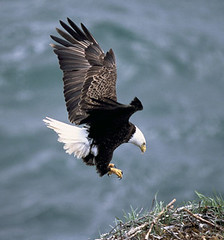 Recent violent territorial disputes among bald eagles, Haliaeetus leucocephalus (pictured), in the Chesapeake Bay could be nature's way of controlling the birds' increasing numbers, experts suggest. For every population there is a gradient of habitat," said Greg Butcher, director of bird conservation at the National Audubon Society. "In other words, there is the best habitat and the good habitat, which is not as good as the best. So what we're seeing [with the eagles] is competition for prime location. It doesn't really mean all the habitat has been used up." According to government estimates, about 7,000 nesting pairs of bald eagles now exist in the wild. [Photographer: Dave Menke/USFWS].
Recent violent territorial disputes among bald eagles, Haliaeetus leucocephalus (pictured), in the Chesapeake Bay could be nature's way of controlling the birds' increasing numbers, experts suggest. For every population there is a gradient of habitat," said Greg Butcher, director of bird conservation at the National Audubon Society. "In other words, there is the best habitat and the good habitat, which is not as good as the best. So what we're seeing [with the eagles] is competition for prime location. It doesn't really mean all the habitat has been used up." According to government estimates, about 7,000 nesting pairs of bald eagles now exist in the wild. [Photographer: Dave Menke/USFWS].
A one year survey by BirdLife Botswana and the Botswana Department of Wildlife and National Parks of the Okavango Delta yielded valuable data on the ecology of the Slaty Egret, Egretta vinaceigula. Despite this, one question remains unanswered: where are Slaty Egrets currently breeding? The species' major historical breeding sites have been destroyed by hydrological changes and fire, and no new sites were discovered in 2005. Continuing survey work hopes to answer this question. Information gathered from these surveys will be incorporated into a Slaty Egret Action Plan that will help BirdLife Botswana, the Department of Wildlife and National Parks and other stakeholders to ensure the Okavango Delta continues to provide a safe haven for Slaty Egrets.
Many bird species live in wetlands, so this story, by National Public Radio's Weekend Edition by Daniel Zwerdling, discusses bird habitat. In short, this story explores the oil and gas industry's damages to southern Louisiana wetlands, made worse by Hurricane Katrina, and who should pay to repair these damages. The industry, obviously, is lobbying the government to force the taxpayer to foot the bill. [RealPlayer: 14:04]
BirdLife International recently published a brief round-up of recently recorded sightings of missing species and new species throughout the world.
The Fine Print: Thanks to my bird pals; Bill, Justawriter, Ian, Diane, Caren, Dawn, Jeremy, Ellen and Ron for some of the news story links that you are enjoying here. Thanks to Ian for catching my typos (I put those there for you to find, you know!). All images that appear here are either linked from the news stories that they accompany or they are linked to the site where they are found, and most of them are resized. You can follow these links by clicking on individual images. The featured image at the top appears here by permission of the photographer. Please $upport these featured photographers by purchasing images from them.
Previous : : Birds in the News : : Next
tags: Birds in the News, ornithology, birds, avian, newsletter


As a complete non-expert, I find the second hypothesis about wing development more compelling than the first. Bird wings aren't just flaps of skin, but systems of muscles and bone structure. For those systems to support powered flight rather than gliding, I think there would have to be some powered usage from the beginning.
My interest is with the use of computers to help aquaculturists. This has been a problem for years and hard for both sides of the living beings on the 'farm'. This is an interesting approach and could have larger significance such as keeping toddlers away from the candy isle or husbands from -well wherever we want to keep them.
Lots of news here, and a lot of it distressing. I have been wondering about global warming and the effect on migratory birds. That's only going to get worse. Thanks for putting this all together.
As always this is an excellent piece of journalism. I have been seeing papers in the literature about assisted climbing as the original advantage conferred by the early evolution of winglike structures in dinosaurs; thank you for covering that issue in the current edition of BITN.
I remember reading in an article or book on evolutionary biology (for the general reader) an interview with a cladistics specialist in taxonomy. He was very dismissive about the kind of discussion you mention above about the origins of flight - he basically said that it is nothing more than pure speculation that serves no useful purpose and only a cladistics approach that outlines "shared derived characteristics" and evolutionary relationships is valid.
Is there still a lot of disagreement within evolutionary biology about cladistics and taxonomy and what questions about the past are worth asking?
Do you know that Kodak has a bird cam too? It is not a live streaming feed; it is a set of cameras that take still photos about every 30 seconds. Peregrine Falcons have been nesting in the Kodak headquarters building at Rochester NY for around 5 years. Their website not only has photographs, but has histories of the various falcons who nest there.
http://www.kodak.com/eknec/PageQuerier.jhtml?pq-locale=en_US&pq-path=20…
The babies are usually banded in June.
John, i agree.
Matt, i have discovered that, as in any field of science, some evolutionary biologists can be astonishingly narrow-minded. those who use cladistics are no different from the rest of the crowd. however, that said, cladistics is a tool that scientists use to gain a greater understanding of evolution, but it is not the only tool, nor is it even the best tool for every "problem" out there.
NancyJane, i included your link in the next week's Birds in the News. thanks!
Thanks again for the excellent edition. I am a bit behind having been on vacation for two weeks. I'll catch up.